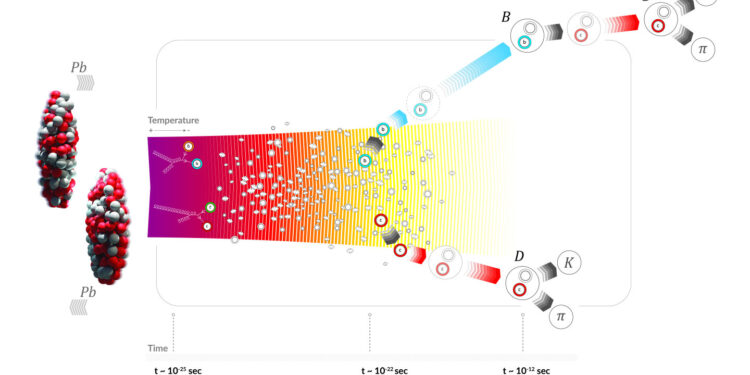ALICE analyzed non-frontal lead-lead collisions and compared the elliptical flux of D mesons produced just after the collisions (so-called “fast” D mesons) with that of those produced later in the decays of B mesons (D mesons). called “fast”). “D mesons). Credit: CERN
When two lead ions collide at the Large Hadron Collider (LHC), they produce an extremely hot and dense state of matter in which quarks and gluons are unconfined in composite particles called hadrons. This fireball of particles, known as quark-gluon plasma and thought to have filled the universe in the first millionths of a second after the Big Bang, is expanding and cooling rapidly. The quarks and gluons then transform back into hadrons, which fly out of the collision zone towards the particle detectors.
In collisions where the two lead ions do not collide head-on, the region of overlap between the ions has an elliptical shape that leaves an imprint on the hadron flow. Measurements of such an elliptical flow provide a powerful way to study the quark-gluon plasma. In a recent article published on the arXiv preprint server, the ALICE collaboration reported a new measurement of the elliptical flow of hadrons containing heavy quarks, which are particularly powerful probes of plasma.
Unlike the gluons and light quarks that make up the bulk of the quark-gluon plasma created in heavy ion collisions, heavy charm and beauty quarks are produced in the early stages of collisions, before plasma forms. They therefore interact with the plasma throughout its evolution, from its expansion and cooling to its transformation into hadrons.
Multiple interactions with the constituents of the plasma bring the heavy quarks into thermal equilibrium with the medium in a time inversely proportional to the mass of the quark. Charm quarks are lighter than beauty quarks, so a shorter thermalization time and a higher degree of thermalization are expected for charm quarks than for beauty quarks.
Once thermalized with the plasma, the charm quarks form D mesons and the beauty quarks form B mesons, combining with the light quarks in the middle (see figure above). Previous measurements have shown that the elliptical flux of these “fast” D mesons, so named because they are produced just after collisions, is almost as strong as that of the lightest hadrons, pions. Since the thermalization time is expected to be longer for beauty quarks than for charm quarks, the elliptical flux of B mesons should be weaker than that of prompt D mesons.
In its recent analysis of the non-frontal lead-lead collisions that occurred during Run 2 of the LHC, the ALICE collaboration measured the elliptical flux of B mesons, by measuring the flux of “non-prompt” D mesons that are produced in the decays. of B mesons. Key to the analysis was the adoption of a machine learning technique to separate the decay products of non-fast D mesons from those of fast mesons, as well as to remove the many particle processes background that mimic the production and decay of D. mesons.
The new measurement shows that the elliptical flux of non-prompt D mesons is weaker than that of their prompt counterparts, in agreement with expectations. The result sheds new light on the thermalization of beauty quarks in quark-gluon plasma and paves the way for new ALICE measurements based on data from the third run of the LHC.
With 40 times more collisions than the total recorded by ALICE during its previous periods of heavy ion data collection, the new sample of lead-lead collisions collected in 2023 will allow the flow of hornbeam particles to be studied in more detail and beauty, losing additional insight into their dynamics in the quark-gluon plasma.
More information:
Measuring D without prompt0-elliptical flow of mesons in Pb-Pb collisions at √sNN = 5.02 TeV, arXiv (2023). DOI: 10.48550/arxiv.2307.14084
Journal information:
arXiv
Quote: New ALICE measurements shed light on the dynamics of charm and beauty particles in quark-gluon plasma (December 15, 2023) retrieved December 16, 2023 from
This document is subject to copyright. Apart from fair use for private study or research purposes, no part may be reproduced without written permission. The content is provided for information only.



